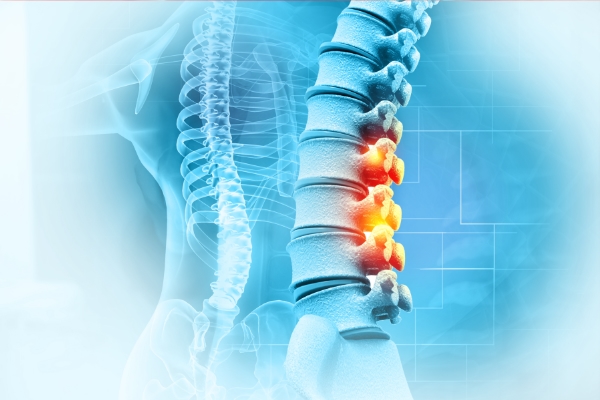Vertebral Compression Fractures
Osteoporotic Vertebral Compression Fractures • Cancer-related Vertebral Compression Fractures

What is a Compression Fracture?
A compression fracture is a common form of a vertebral fracture caused by a loss of bone mass (osteoporosis) that occurs as part of aging. A fall, cough, or lifting of a heavy object may cause a fracture of the back bones. Less frequently, compression fractures can occur secondary bone destruction caused by a tumor.
Symptoms include back pain, lost height, and a hunched-forward posture. Treatments include physical therapy and medications to relieve pain. In a significant number of cases when symptoms are not improving, a procedure may be needed.

What is Kyphoplasty?
Kyphoplasty is a minimally invasive procedure for the treatment of vertebral compression fractures. Your interventional radiologist, using imaging guidance, stabilizes the collapsed vertebra by creating small cavities in the bone and filling them with medical-grade bone cement. This reduces pain, and can prevent further collapse of the vertebra, thereby preventing the height loss and spine curvature commonly seen as a result of osteoporosis. Kyphoplasty dramatically improves back pain within hours of the procedure, provides long-term pain relief and has a low complication rate, as demonstrated in multiple studies.
Who is a Candidate for Kyphoplasty?
The best candidates for the procedure are those people who have recently suffered a compression fracture and are having moderate to severe back pain. Kyphoplasty is not usually helpful for chronic back pain or disc problems. To determine whether Kyphoplasty is the right treatment for the patient, the doctor will order X-rays of the patient’s spine, and other imaging tests such as magnetic resonance imaging (MRI) or a bone scan. These tests help to determine where the fractures are and how recently they occurred.

How is Kyphoplasty Performed?
Kyphoplasty requires that you lie on your stomach, which is performed under light sedation. The interventional radiologist inserts a needle through a small nick in the skin in the back, directing it under fluoroscopy (continuous, moving X-ray imaging) into the fractured vertebra. The physician then places a catheter with a balloon at the tip and creates a small cavity within the vertebra. Then, the physician injects the medical-grade bone cement into the vertebra. The cement hardens within 15 minutes and stabilizes the fracture, like an internal cast. Kyphoplasty takes from 1-2 hours to perform depending on how many bones are treated.
How can Kyphoplasty Help Me?
In most patients, Kyphoplasty provides immediate and lasting relief of pain related to vertebral compression fractures. Many patients return to their normal activities within only a few days of having the procedure, and most report continued relief from pain months and years later.
Benefits:
- Minimally invasive
- Lasts 1-2 hours
- Rapid recovery time
- Immediate pain relief or elimination within 48 hours
What is a Spinal Metastasis?
Many cancers may spread to bone, very often to the spine, and are called spinal metastasis. These cancerous bone and spinal lesions cause pain by releasing chemicals that stimulate pain pathways to our brain, compress nerves, and weaken the bone leading to fractures.
What is Spinal Ablation?
These bone lesions can be treated by accessing the lesion in the bone or vertebral body under imaging guidance. Once this is achieved, a radio-frequency probe is advanced into the tumor, and high frequency energy is deposited in the tissues creating heat that kills the tumor cells. This is most commonly known as ablation and safely performed for painful lesions in the spine.
Who is a Candidate for Spinal Ablation?
Kyphoplasty requires that you lie on your stomach, which is performed under light sedation. The interventional radiologist inserts a needle through a small nick in the skin in the back, directing it under fluoroscopy (continuous, moving X-ray imaging) into the fractured vertebra. The physician then places a catheter with a balloon at the tip and creates a small cavity within the vertebra. Then, the physician injects the medical-grade bone cement into the vertebra. The cement hardens within 15 minutes and stabilizes the fracture, like an internal cast. Kyphoplasty takes from 1-2 hours to perform depending on how many bones are treated.
How is Spinal Ablation Performed?
Kyphoplasty requires that you lie on your stomach, which is performed under light sedation. The interventional radiologist inserts a needle through a small nick in the skin in the back, directing it under fluoroscopy (continuous, moving X-ray imaging) into the fractured vertebra. The physician then places a catheter with a balloon at the tip and creates a small cavity within the vertebra. Then, the physician injects the medical-grade bone cement into the vertebra. The cement hardens within 15 minutes and stabilizes the fracture, like an internal cast. Kyphoplasty takes from 1-2 hours to perform depending on how many bones are treated.
How can Spinal Ablation Help Me?
In most patients, Spinal Ablation provides immediate and lasting relief of pain related to metastatic spinal lesions. It may be allow patients to return to their normal activities or help them tolerate chemo-radiation treatments that tend to require multiple sessions of lying on their backs. Although, not extensively studied, spinal ablation may help control the local extension of cancer.
Varicocele Embolization
A very small skin incision is made at a site in the groin or neck, and a long, thin, hollow plastic tube (catheter) is then maneuvered through the venous system until it reaches the gonadal veins. Tiny coils and sclerosing agent are then injected through the catheter, resulting in permanent blockage (embolization) of the veins. Over time, this prevents pooling of blood and these abnormal veins shrink or disappear. The procedure is nearly painless and done under sedation, avoiding the need for general anesthesia. Patients are able to return home the same day as the procedure and resume normal activities within a few days. When compared to surgical alternatives, varicocele embolization is equally as effective and has a lower risk of complications and a shorter recovery time.
TESTIMONIALS
What Our Patients Are Saying
Dr Gonzalez performed prostate pae surgery on me; he explained everything throughly beforehand and I am having wonderful results from same. Dr Gonzalez and his staff are amazing and caring people and I highly recommend.
David M.
Dr. Gonzalez is amazing. He was able to find a rare condition I have that multiple other physicians did not pick up. He is both caring and knowledgeable. He explained all procedures and outcomes clearly and was available for my questions and concerns even after my procedure. He is a five star doctor and I would highly recommend him!
Adrienne V.
Dr. Gonzalez-Beicos and his staff are very professional, knowledgeable, friendly and caring. After dealing for 10 years with BPH, five biopsies, two TURP and three hospitalizations for complications I want to thank Dr. Gonzalez-Beicos and his team. They did and excellent job with a procedure called Prostatic Artery Embolization. I recovered fast and finally I can say that I’m back to normal. I would and do highly recommend him.
Jorge M.


